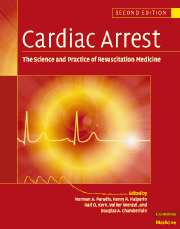Book contents
- Frontmatter
- Contents
- List of contributors
- Foreword
- Preface
- Part I Introduction
- Part II Basic science
- Part III The pathophysiology of global ischemia and reperfusion
- Part IV Therapy of sudden death
- Part V Postresuscitation disease and its care
- Part VI Special resuscitation circumstances
- 52 Prevention of sudden death in patients at risk: channelopathies and arrhythmic syndromes in the structurally normal heart
- 53 Pediatric cardiopulmonary resuscitation
- 54 Resuscitation in elder persons
- 55 Asphyxial cardiac arrest
- 56 Hemorrhagic shock and hypovolemic cardiac arrest
- 57 Cardiopulmonary resuscitation in hypothermic patients
- 58 Cardiac arrest due to poisoning
- 59 Cardiac arrest during anesthesia
- 60 Resuscitation of the pregnant patient suffering sudden cardiac death
- 61 Drowning
- 62 Anaphylactic shock
- 63 High altitude resuscitation
- 64 Electrical injuries
- 65 Rare syndromes, commotio cordis, sudden death in athletes
- Part VII Special issues in resuscitation
- Index
62 - Anaphylactic shock
from Part VI - Special resuscitation circumstances
Published online by Cambridge University Press: 06 January 2010
- Frontmatter
- Contents
- List of contributors
- Foreword
- Preface
- Part I Introduction
- Part II Basic science
- Part III The pathophysiology of global ischemia and reperfusion
- Part IV Therapy of sudden death
- Part V Postresuscitation disease and its care
- Part VI Special resuscitation circumstances
- 52 Prevention of sudden death in patients at risk: channelopathies and arrhythmic syndromes in the structurally normal heart
- 53 Pediatric cardiopulmonary resuscitation
- 54 Resuscitation in elder persons
- 55 Asphyxial cardiac arrest
- 56 Hemorrhagic shock and hypovolemic cardiac arrest
- 57 Cardiopulmonary resuscitation in hypothermic patients
- 58 Cardiac arrest due to poisoning
- 59 Cardiac arrest during anesthesia
- 60 Resuscitation of the pregnant patient suffering sudden cardiac death
- 61 Drowning
- 62 Anaphylactic shock
- 63 High altitude resuscitation
- 64 Electrical injuries
- 65 Rare syndromes, commotio cordis, sudden death in athletes
- Part VII Special issues in resuscitation
- Index
Summary
The discovery of anaphylaxis
In 1902, Richet and Portier were attempting to immunize dogs with venom extracted from sea anemones (Actinia). To their surprise, instead of being protected, some dogs had apparently become more sensitive to the effect of the venom: they became acutely ill and died within minutes of the second injection. They had expected protection (prophylaxis) but had, they thought, achieved the opposite, which they termed anaphylaxis. It soon became clear that this was not enhanced toxicity of the venom, but rather a dangerously severe acute allergic reaction that could equally be triggered by non-toxic proteins. Prausnitz demonstrated in 1921 that this hypersensitivity could be transferred by a heat-labile component of the serum, but it was not until 1966 that the Ishizakas identified this component as immunoglobulin E (IgE).
Hypersensitivity reactions take many forms and these were classified in 1968 by Gell and Coombes; IgEmediated hypersensitivity was labelled type I. More recently, the nomenclature committee of the European Academy of Allergy and Clinical Immunology (EAACI) has recommended it should simply be called “IgE-mediated hypersensitivity.”
Definitions of anaphylaxis
The term “anaphylaxis” has been used for all types of acute life-threatening illness triggered by abnormal sensitivity to a trigger agent, and for apparently spontaneous attacks with similar features (idiopathic anaphylaxis). This has made it difficult to define. The EAACI Nomenclature Committee proposed the following broad definition:
Anaphylaxis is a severe, life-threatening, generalized or systemic hypersensitivity reaction.
- Type
- Chapter
- Information
- Cardiac ArrestThe Science and Practice of Resuscitation Medicine, pp. 1103 - 1117Publisher: Cambridge University PressPrint publication year: 2007



